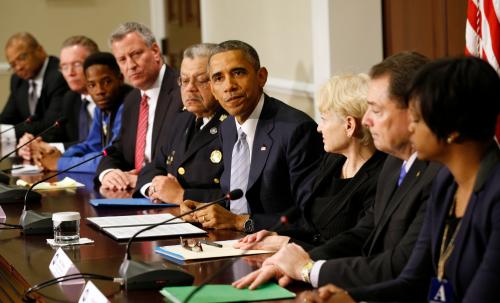Creating pathways to opportunity is one of the most complex challenges that cities face. Supporting the needs of all residents—particularly those born into poverty—takes targeted interventions at multiple stages of life. The obstacles vary from place to place, but there is one challenge all communities have in common: making sense of the complex patchwork of federal funding that supports opportunities for young people.
As noted in a recent Brookings report by Martha Ross and Nicole Prchal Svajlenka, the stakes are particularly high when it comes to disconnected or “opportunity youth,” 16- to 24-year olds out of school and out of work. Federal resources often fill critical gaps in financing the delivery of essential programs and services to this group. But the way Washington provides these resources is fundamentally misaligned with localities’ desire to provide these things along a continuum to the individuals and families who need them most. A recent report, “Accounting for Opportunity: A Fiscal Scan of Funding for New Orleans Opportunity Youth,” by the Forum for Youth Investment, the Cowen Institute, and the Baptist Community Ministries, shows how this fragmentation plays out in New Orleans and brings to the fore the piecemeal, fragmented, one-size-fits-all approach that Washington often takes to supporting local efforts.
For example, the report identifies 51 separate federal funding streams that are designed (at least partially) to support opportunity youth in communities around the nation. These funding streams span seven different agencies, consisting of 15 separate programs from the Department of Labor, 14 from the Department of Health and Human Services, 11 from the Department of Education, and 11 from four other agencies. Within each agency, some grant programs are broad in scope while others are hyper-specific. Some are distributed by need through formulas, while others are allocated on a discretionary or competitive basis. Some pass through states while others go directly to cities. The full landscape of programs is dizzying in its complexity, slow to adapt to rapid changes, and rife with uncertainty for the grant recipients, making long-term planning difficult. For any city, cobbling together all of these separate funding streams into an effective, locally tailored strategy is a daunting—and costly—task.
In the case of New Orleans, a city with the third-highest percentage of opportunity youth among major U.S. metros (according to “Accounting for Opportunity,” 18.2 percent of its 16- to 24-year-olds are considered at risk), local officials must navigate eight separate funding streams for workforce development, six for education, eight for human services, and six for justice, housing, and other services. Some of the grants are core components of the national safety net, like Temporary Assistance for Needy Families and the Supplemental Nutrition Assistance Program. Others, like the $7.2 million the city receives for Job Corps, must be used for very particular purposes—in this case, funding a residential education and job-training program that takes in around 100 students per year, just 0.3 percent of the 26,000 or so opportunity youth in the city. Ten of the grants the city receives are less than $2 million, and several are so small that they can hardly be cost-effective to administer.
Does anyone really think that this is the most effective way for the federal government to support the efforts of New Orleans (or any city) to improve outcomes for at-risk youth? This approach may have made sense decades ago, when the federal government was providing much greater financial support for cities, and local governments were just beginning to build up the coordinating capacity needed to leverage civic- and private-sector partnerships in delivering services more effectively. But times have changed. While the federal government and many states have drifted, cities across the country have stepped up to propel communities forward.
One possible alternative: radically increase the funding flexibility granted to cities with sound plans to coordinate services. The federal government could consider emulating the “City Deals” process underway in the United Kingdom, where cities “apply” to Britain’s central government with proposals of how they would use federal resources if given full discretion. Creating a process for American cities to apply for “Youth Budgets” could both spark creative, local approaches to problem-solving and improve outcomes. If granted, the disparate funding streams going into a city could be bundled into one grant, and the city would be obligated to carry out its plans as proposed during negotiations. By granting flexibility on the basis of competition, highly capable cities could serve as models for the rest.
There is precedent for this kind of flexibility. The longstanding community development block grant funds administered by the Department of Housing and Urban Development provide localities with one of few sources of relatively stable funds with few restrictions. And more recent encouraging signs suggest that the federal government has begun to understand the importance of increasing discretion and flexibility to cities. Several programs introduced by the Obama Administration, including the Performance Pilot Partnerships for Disconnected Youth and the Upward Mobility Project, have rewarded cities that show how good use of combined funding streams can more effectively provide supports that improve social mobility. Though these programs are small, they are pointing in the right direction.
The next president must recognize that the stove-piped, fragmented way that the federal government provides support to cities—not only for opportunity youth but also across a wide range of policy areas—has limited effectiveness and is costly to taxpayers. In cities with sufficient public- and civic-sector capacity, local challenges can be more efficiently addressed with locally designed strategies and solutions. The federal government should see itself as a partner and capacity-builder that leverages and amplifies local creativity and solutions, not as a decider that dictates how funding should be used. Cities are growing up, and it’s time the federal government respected their maturity. There is no better place to start the shift to a new federalist arrangement than with the way we invest in our children and our future.
The Brookings Institution is committed to quality, independence, and impact.
We are supported by a diverse array of funders. In line with our values and policies, each Brookings publication represents the sole views of its author(s).






Commentary
A new federalist arrangement for disconnected youth
May 25, 2016